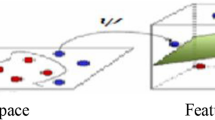Abstract
Automated segmentation of different tissue regions from brain magnetic resonance (MR) imaging has a substantial impact on many computer-assisted neuro-imaging studies. Major challenges to accomplish this task emerge from limited spatial resolution, signal-to-noise ratio, and RF coil inhomogeneity. These imaging artifacts lead to fuzziness of tissue boundaries and uncertainty in MR intensity-based tissue characterization at individual image voxels. The conventional fuzzy c-means (FCM) algorithm fails to produce satisfactory results for noisy image. In this paper, we present an entropy-based FCM segmentation method that incorporates the uncertainty of classification of individual pixels within the classical framework of FCM. Furthermore, instead of Euclidean distance, we have defined the non-Euclidean distance based on Gaussian probability density function. The new segmentation method was applied to Brainweb brain MR database at varying noise and inhomogeneity, and its performance was compared with existing FCM-based algorithms. The proposed method yields superior performance over some classical state-of-the-art methods. In addition to this, we also have performed the proposed method on some in vivo human brain MR data to demonstrate its performance.


Similar content being viewed by others
Explore related subjects
Discover the latest articles, news and stories from top researchers in related subjects.Notes
Brainweb brain database: http://www.bic.mni.ca/brainweb/.
References
Abdel-Khalek S, Ishak AB, Omer OA, Obada AS (2017) A two-dimensional image segmentation method based on genetic algorithm and entropy. Opt Int J Light Electron Opt 131:414–422
Ahmed MN, Yamany SM, Mohamed N, Farag AA, Moriaty T (2002) A modified fuzzy c-means algorithm for bias field estimation and segmentation on MRI data. IEEE Trans Med Imaging 21(3):193–199
Askari S, Montazerin M, Zarandi MF, Hakimi E (2017) Generalized entropy based possibilistic fuzzy c-means for clustering noisy data and its convergence proof. Neurocomputing 219:186–202
Balafar MA, Ramli AR, Saripan MI, Mashohor S (2010) Review of brain MRI image segmentation methods. J Artif Intell 33(3):261–274
Banerjee A, Maji P (2013) Rough sets for bias correction in MR images using contraharmonic mean and quantitative index. IEEE Trans Med Imaging 32(11):2140–2151
Cai W, Chen S, Zhang D (2007) Fast and robust fuzzy c-means clustering algorithms incorporating local information for image segmentation. Pattern Recognit 40(3):825–838
Chuang KS, Tzeng HL, Chen S, Wu J, Chen TJ (2006) Fuzzy c-means clustering with spatial information for image segmentation. Comput Med Imaging Graph 30(1):9–15
Gharieb RR, Gendy G, Abdelfattah A (2017) C-means clustering fuzzified by two membership relative entropy functions approach incorporating local data information for noisy image segmentation. SIViP 11(3):541–548
Jaffar MA, Hussain A, Mirza AM (2010) Fuzzy entropy based optimization of clusters for the segmentation of lungs in CT scanned images. Knowl Inf Syst 24(1):91–111
Jenssen R, Hild KE, Erdomus D, Principie JC, Eltoft T (2003) Clustering using Renyi’s entropy. In: Proceedings of international joint conference on neural networks, IEEE, vol 1, pp 523–528
Nayak J, Naik B, Behera HS (2015) Fuzzy c-means (FCM) clustering algorithm: a decade review from 2000 to 2014. Comput Intell Data Min 2:133–149
Olabarriaga SD, Smeulders AW (2001) Interaction in the segmentation of medical images: a survey. Med Image Anal 5(2):127–142
Pal NR, Pal K, Keller JC (2005) A possibilistic fuzzy c-means clustering algorithm. IEEE Trans Fuzzy Syst 13(4):517–530
Pedrycz W (1996) Conditional fuzzy c-means. Pattern Recognit Lett 17(6):625–631
Pham DL, Xu C, Prince JL (2000) Current methods in medical image segmentation. Annu Rev Biomed Eng 2(1):315–327
Rajnikanth V, Satapathy SC, Farnendes SL, Nachiappan S (2017) Entropy based segmentation of tumor from brain MR images—a study with teaching learning based optimization. Pattern Recognit Lett 94:87–95
Saha PK, Udupa JK (2001) Optimum image thresholding via class uncertainty and region homogeneity. IEEE Trans Pattern Anal Mach Intell 23(7):689–706
Simmons A, Tofts PS, Barker GJ, Arridge SR (1994) Sources of intensity nonuniformity in spin echo images at 1.5 T. Magn Reson Med 32(1):121–128
Wang X, Song Q, Soh YC, Sim K (2013) An adaptive spatial information-theoretic fuzzy clustering algorithm for image segmentation. Comput Vis Image Underst 117(10):1412–1420
Yao J, Dash M, Tan ST, Liu H (2000) Entropy-based fuzzy clustering and fuzzy modeling. Fuzzy Sets Syst 113(3):381–388
Zarinbal M, Zarandi MF, Turksen IB (2014) Relative entropy fuzzy c-means clustering. Inf Sci 260(2014):74–97
Acknowledgements
This work is partially supported by the SERB, DST, Govt. of India, sponsored research project (File No: EEQ/2016/000145; dated: December 8, 2016). Authors are indebted to Dr. S. K. Sharma, Dr. J. Sharma, and Dr. Sumita Kundu, radiologist of EKO X-RAY & IMAGING INSTITUTE, Kolkata, for their support. Authors are also thankful to Mr. Banshadhar Nandi and Mr. Niloy Halder, Sr. Technologist (Imaging), AMRI, Dhakuria, for their support and providing the real-patient images.
Author information
Authors and Affiliations
Corresponding author
Ethics declarations
Conflict of interest
The authors declare that they have no conflict of interest.
Additional information
Communicated by V. Loia.
Publisher’s Note
Springer Nature remains neutral with regard to jurisdictional claims in published maps and institutional affiliations.
Rights and permissions
About this article
Cite this article
Kahali, S., Sing, J.K. & Saha, P.K. A new entropy-based approach for fuzzy c-means clustering and its application to brain MR image segmentation. Soft Comput 23, 10407–10414 (2019). https://doi.org/10.1007/s00500-018-3594-y
Published:
Issue Date:
DOI: https://doi.org/10.1007/s00500-018-3594-y




